外研版八年级英语下册 Module1 Unit 重难点课件(17张)
文档属性
| 名称 | 外研版八年级英语下册 Module1 Unit 重难点课件(17张) | 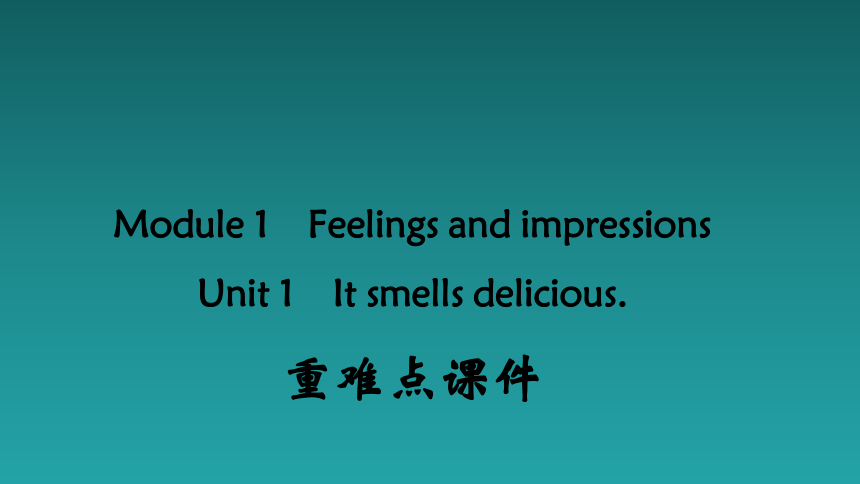 | |
| 格式 | ppt | ||
| 文件大小 | 2.0MB | ||
| 资源类型 | 教案 | ||
| 版本资源 | 外研版 | ||
| 科目 | 英语 | ||
| 更新时间 | 2022-06-13 16:11:04 | ||
图片预览

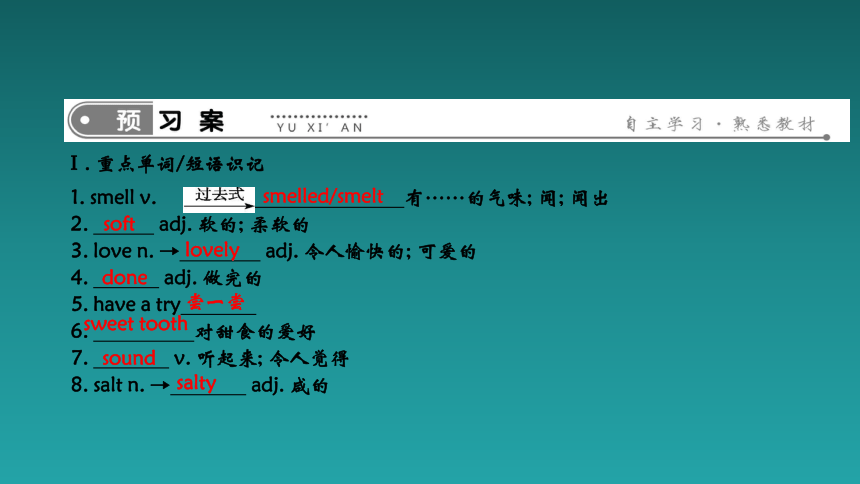
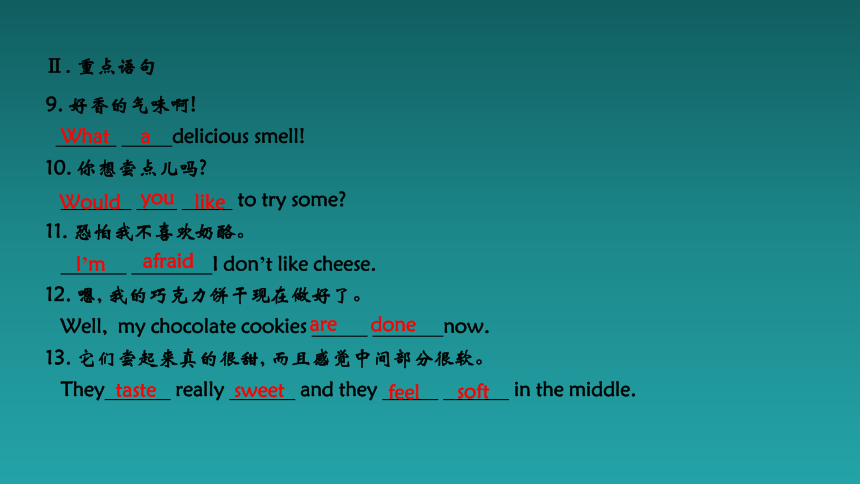
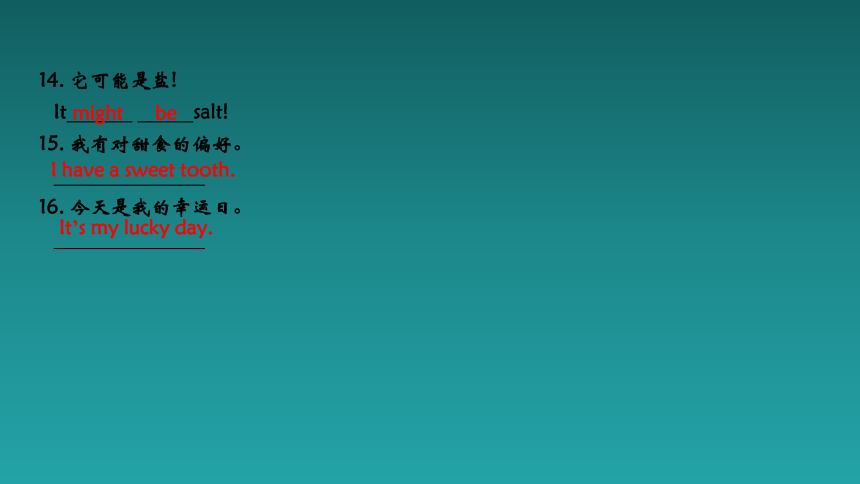
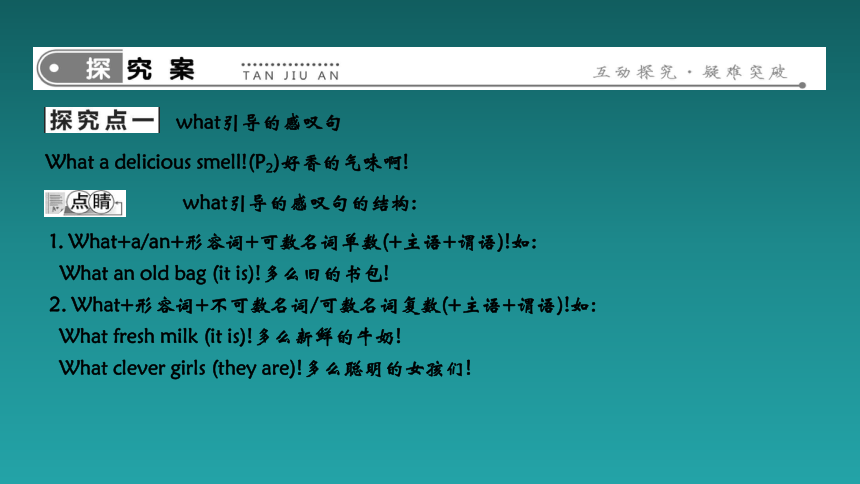
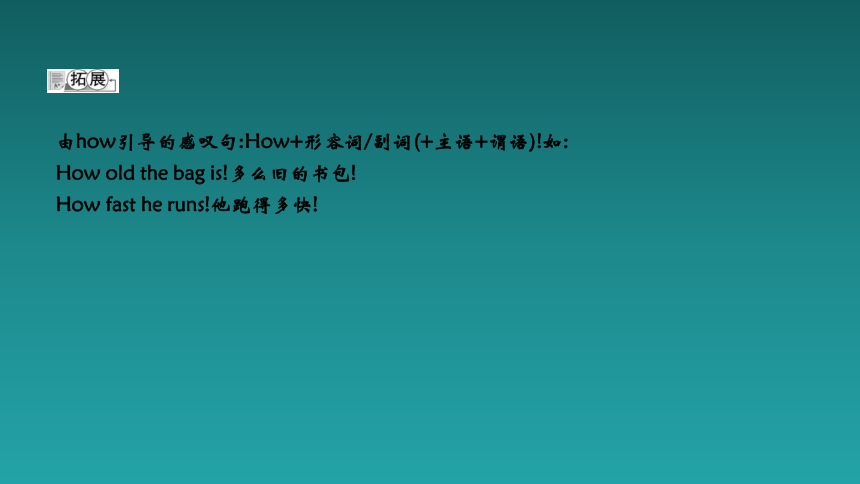
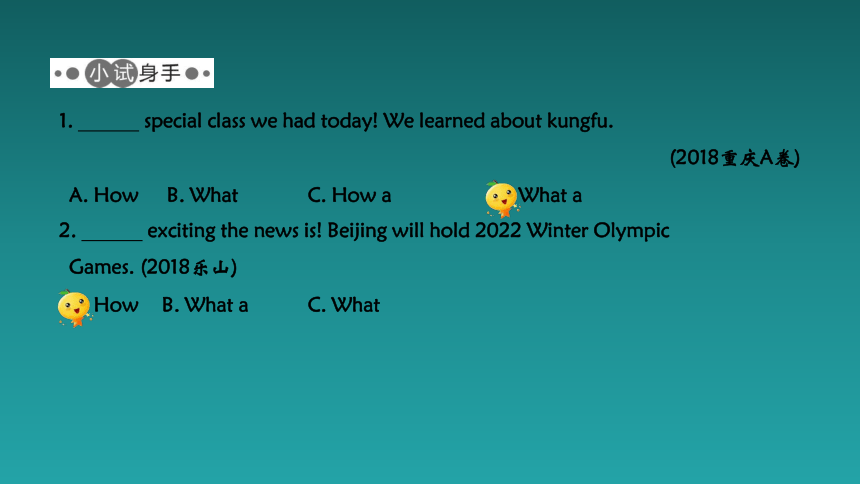
文档简介
(共17张PPT)
Module 1 Feelings and impressions
Unit 1 It smells delicious.
重难点课件
Ⅰ. 重点单词/短语识记
1. smell v. 有……的气味; 闻; 闻出
2. adj. 软的; 柔软的
3. love n. → adj. 令人愉快的; 可爱的
4. adj. 做完的
5. have a try
6. 对甜食的爱好
7. v. 听起来; 令人觉得
8. salt n. → adj. 咸的
smelled/smelt
soft
lovely
done
尝一尝
sweet tooth
sound
salty
9. 好香的气味啊!
delicious smell!
10. 你想尝点儿吗
to try some
11. 恐怕我不喜欢奶酪。
I don’t like cheese.
12. 嗯, 我的巧克力饼干现在做好了。
Well, my chocolate cookies now.
13. 它们尝起来真的很甜, 而且感觉中间部分很软。
They really and they in the middle.
Ⅱ. 重点语句
What
a
Would
you
like
I’m
afraid
are
done
taste
sweet
feel
soft
14. 它可能是盐!
It salt!
15. 我有对甜食的偏好。
16. 今天是我的幸运日。
might
be
I have a sweet tooth.
It’s my lucky day.
what引导的感叹句
What a delicious smell!(P2)好香的气味啊!
what引导的感叹句的结构:
1. What+a/an+形容词+可数名词单数(+主语+谓语)!如:
What an old bag (it is)!多么旧的书包!
2. What+形容词+不可数名词/可数名词复数(+主语+谓语)!如:
What fresh milk (it is)!多么新鲜的牛奶!
What clever girls (they are)!多么聪明的女孩们!
由how引导的感叹句:How+形容词/副词(+主语+谓语)!如:
How old the bag is!多么旧的书包!
How fast he runs!他跑得多快!
1. special class we had today! We learned about kungfu.
(2018重庆A卷)
A. How B. What C. How a D. What a
2. exciting the news is! Beijing will hold 2022 Winter Olympic
Games. (2018乐山)
A. How B. What a C. What
smell的用法
It looks lovely, it smells delicious, and mm, it tastes good. (P2)它看上去不错, 闻起来香喷喷的, 唔, 尝起来很好吃。
smell作系动词, 意为“闻起来”, 后接形容词作表语。类似的动词有look(看起来); taste(尝起来); feel(摸起来); sound(听起来)。
smell作名词, 意为“气味”。是可数名词。
What a delicious smell in the kitchen!
厨房里的味道多好闻啊!
1. The cheese cake so good that I can’t wait to eat it.
(2018温州)
A. tastes B. feels
C. sounds D. smells
2. —The chocolate bread you want is done now.
—What delicious smell.
A. the B. / C. a D. an
Would you like to. . . 句型
Would you like to try some (P2)你想尝点儿吗
Would you like to do sth. 该句型带有委婉的语气, 可以用来征求意见、提出建议或发出邀请, 意为“你想做某事吗 ”其肯定回答常用“Yes, I’d like/love to. ”“Sure, that sounds great. ”等; 其否定回答常用“I’d like/
love to, but. . . ”“Thank you, but I’m afraid. . . ”等。
句型Would you like sth. 表示“你想要某物吗 ” 其肯定回答常用“Yes, please. ”等; 其否定回答常用“No, thanks. ”等。
1. —Would you like to go to the movies with me this Sunday
— . I’ll be free that day.
A. Sorry, I can’t B. Yes, I do
C. Yes, I’d love to D. No, I wouldn’t
2. —Would you like something to eat
— I’ve had enough.
A. Yes, I would. B. Yes, please.
C. No, I wouldn’t. D. No, thanks.
try的用法
Have a try!(P2)尝一尝!
try作名词, 意为“尝试; 努力”, 常构成短语have a try“尝一尝; 试试看”。
1. 你为什么不尝试一下呢
Why don’t you
2. 为什么不试着骑车去学校呢
Why didn’t you a bike to go to school
3. —I didn’t hear you come in just now.
—That’s good. I tried the baby up.
A. to wake B. not to wake
C. waking
have
a
try
try
riding
sound的用法
Apple pie sounds nice. (P2)苹果派听起来不错。
sound用作系动词, 后接形容词作表语。
sound还可以作名词, 意为“声音”。
辨析:sound, voice与noise
sound 意为“声音”, 指各种各样的声音。
voice 指“嗓音”, 指人嗓子发出的声音。
noise 指“噪音”, make noises制造噪音。
1. —Do you like the songs sung by Taylor
—Yes. Country music nice and is full of feelings.
A. sounds B. listens
C. hears D. looks
2. —Did you hear any strange when the earthquake happened
—No, I was in my garden with my flowers and was enjoying the beautiful of my birds at that time.
A. voice; noise B. noise; sound
C. voice; sound D. sound; voice
3. Linda has a beautiful . She sings very well.
A. look B. sound C. voice
be done的用法
Well, my chocolate cookies are done now. (P2)
嗯, 我的巧克力饼干现在做好了。
be done表示“做好了, 完成了”。
1. 那支铅笔你用完了吗
you with that pencil
2. 现在鱼汤做好了。
The fish soup now.
Are
done
is
done
Module 1 Feelings and impressions
Unit 1 It smells delicious.
重难点课件
Ⅰ. 重点单词/短语识记
1. smell v. 有……的气味; 闻; 闻出
2. adj. 软的; 柔软的
3. love n. → adj. 令人愉快的; 可爱的
4. adj. 做完的
5. have a try
6. 对甜食的爱好
7. v. 听起来; 令人觉得
8. salt n. → adj. 咸的
smelled/smelt
soft
lovely
done
尝一尝
sweet tooth
sound
salty
9. 好香的气味啊!
delicious smell!
10. 你想尝点儿吗
to try some
11. 恐怕我不喜欢奶酪。
I don’t like cheese.
12. 嗯, 我的巧克力饼干现在做好了。
Well, my chocolate cookies now.
13. 它们尝起来真的很甜, 而且感觉中间部分很软。
They really and they in the middle.
Ⅱ. 重点语句
What
a
Would
you
like
I’m
afraid
are
done
taste
sweet
feel
soft
14. 它可能是盐!
It salt!
15. 我有对甜食的偏好。
16. 今天是我的幸运日。
might
be
I have a sweet tooth.
It’s my lucky day.
what引导的感叹句
What a delicious smell!(P2)好香的气味啊!
what引导的感叹句的结构:
1. What+a/an+形容词+可数名词单数(+主语+谓语)!如:
What an old bag (it is)!多么旧的书包!
2. What+形容词+不可数名词/可数名词复数(+主语+谓语)!如:
What fresh milk (it is)!多么新鲜的牛奶!
What clever girls (they are)!多么聪明的女孩们!
由how引导的感叹句:How+形容词/副词(+主语+谓语)!如:
How old the bag is!多么旧的书包!
How fast he runs!他跑得多快!
1. special class we had today! We learned about kungfu.
(2018重庆A卷)
A. How B. What C. How a D. What a
2. exciting the news is! Beijing will hold 2022 Winter Olympic
Games. (2018乐山)
A. How B. What a C. What
smell的用法
It looks lovely, it smells delicious, and mm, it tastes good. (P2)它看上去不错, 闻起来香喷喷的, 唔, 尝起来很好吃。
smell作系动词, 意为“闻起来”, 后接形容词作表语。类似的动词有look(看起来); taste(尝起来); feel(摸起来); sound(听起来)。
smell作名词, 意为“气味”。是可数名词。
What a delicious smell in the kitchen!
厨房里的味道多好闻啊!
1. The cheese cake so good that I can’t wait to eat it.
(2018温州)
A. tastes B. feels
C. sounds D. smells
2. —The chocolate bread you want is done now.
—What delicious smell.
A. the B. / C. a D. an
Would you like to. . . 句型
Would you like to try some (P2)你想尝点儿吗
Would you like to do sth. 该句型带有委婉的语气, 可以用来征求意见、提出建议或发出邀请, 意为“你想做某事吗 ”其肯定回答常用“Yes, I’d like/love to. ”“Sure, that sounds great. ”等; 其否定回答常用“I’d like/
love to, but. . . ”“Thank you, but I’m afraid. . . ”等。
句型Would you like sth. 表示“你想要某物吗 ” 其肯定回答常用“Yes, please. ”等; 其否定回答常用“No, thanks. ”等。
1. —Would you like to go to the movies with me this Sunday
— . I’ll be free that day.
A. Sorry, I can’t B. Yes, I do
C. Yes, I’d love to D. No, I wouldn’t
2. —Would you like something to eat
— I’ve had enough.
A. Yes, I would. B. Yes, please.
C. No, I wouldn’t. D. No, thanks.
try的用法
Have a try!(P2)尝一尝!
try作名词, 意为“尝试; 努力”, 常构成短语have a try“尝一尝; 试试看”。
1. 你为什么不尝试一下呢
Why don’t you
2. 为什么不试着骑车去学校呢
Why didn’t you a bike to go to school
3. —I didn’t hear you come in just now.
—That’s good. I tried the baby up.
A. to wake B. not to wake
C. waking
have
a
try
try
riding
sound的用法
Apple pie sounds nice. (P2)苹果派听起来不错。
sound用作系动词, 后接形容词作表语。
sound还可以作名词, 意为“声音”。
辨析:sound, voice与noise
sound 意为“声音”, 指各种各样的声音。
voice 指“嗓音”, 指人嗓子发出的声音。
noise 指“噪音”, make noises制造噪音。
1. —Do you like the songs sung by Taylor
—Yes. Country music nice and is full of feelings.
A. sounds B. listens
C. hears D. looks
2. —Did you hear any strange when the earthquake happened
—No, I was in my garden with my flowers and was enjoying the beautiful of my birds at that time.
A. voice; noise B. noise; sound
C. voice; sound D. sound; voice
3. Linda has a beautiful . She sings very well.
A. look B. sound C. voice
be done的用法
Well, my chocolate cookies are done now. (P2)
嗯, 我的巧克力饼干现在做好了。
be done表示“做好了, 完成了”。
1. 那支铅笔你用完了吗
you with that pencil
2. 现在鱼汤做好了。
The fish soup now.
Are
done
is
done
同课章节目录
- Module 1 Feelings and impressions
- Unit 1 It smells delicious.
- Unit 2 I feel nervous when I speak Chinese .
- Unit 3 Language in use
- Module 2 Experiences
- Unit 1 I've also entered lots of speaking competi
- Unit 2 They have seen the Pyramids.
- Unit 3 Language in use
- Module 3 Journey to space
- Unit 1 Has it arrived yet?
- Unit 2 We have not found life on any other planet
- Unit 3 Language in use
- Module 4 Seeing the docto
- Unit 1 I haven't done much exercise since I got m
- Unit 2 We have played football for a year now
- Unit 3 Language in use
- Module 5 Cartoons
- Unit 1 It's time to watch a cartoon.
- Unit 2 Tintin has been popular for over eighty yea
- Unit 3 Language in use
- Revision module A
- Module 6 Hobbies
- Unit 1 Do you collect anything ?
- Unit 2 Hobbies can make you grow as a person.
- Unit 3 Language in use
- Module 7 Summer in Los Angeles
- Unit 1 Please write to me and send me some photos
- Unit 2 Fill out a form and come to learn English
- Unit 3 Language in use
- Module 8 Time off
- Unit 1 I can hardly believe we are in the city ce
- Unit 2 We thought somebody was moving about
- Unit 3 Language in use
- Module 9 Friendship
- Unit 1 Could I ask if you've mentioned this to he
- Unit 2 I believe that the world is what you think
- Unit 3 Language in use
- Module 10 On the radio
- Unit 1 I hope that you can join us one day
- Unit 2 It seemed that they were speaking to me in
- Unit 3 Language in use
- Revision module B
